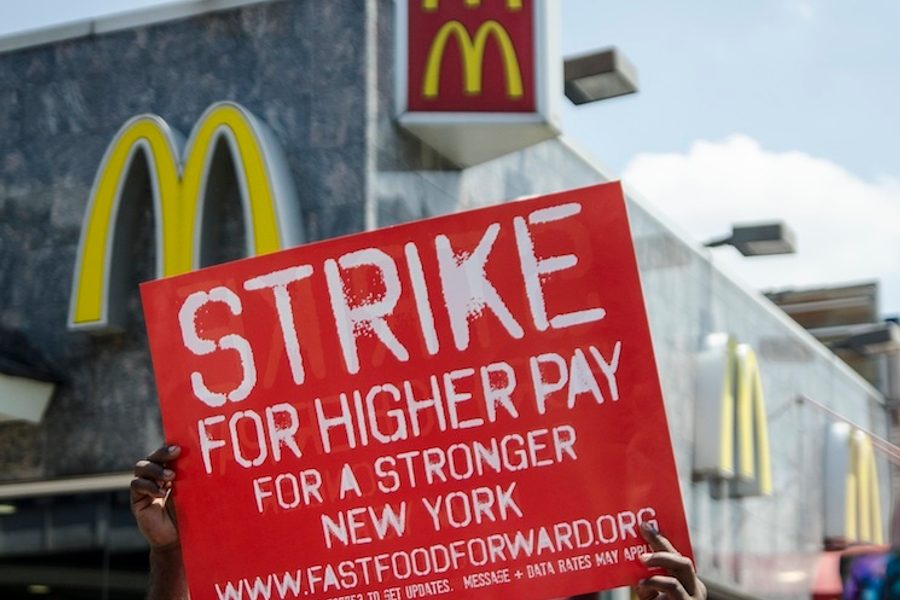The U.S. Chamber of Secrets
Who’s funding the Chamber of Commerce and its attacks on workers’ rights groups? No one knows.
Mariya Strauss

The U.S. Chamber of Commerce’s stated mission is “representing the interests of more than 3 million businesses of all sizes, sectors, and regions,” but watchdog groups say the U.S. Chamber represents the interests of a select few big industry groups that want to crush worker organizing. In some states, where the local Chamber of Commerce and local business leaders tend to operate from the same playbook as the U.S. Chamber, anti-worker campaigns tend to proliferate. The California Chamber of Commerce, for example, has been actively lobbying to prevent the state legislature from passing a bill that would help to prevent wage theft.
But identifying who is — and isn’t — part of the U.S. Chamber can be a challenge. Unlike many local Chambers of Commerce, the U.S. Chamber keeps its member and donor lists secret. Despite its claim to represent three million businesses, watchdog groups have documented that its actual membership hovers around 300,000. What’s more, local chambers of commerce have publicly denounced or left the U.S. Chamber by the dozens in recent years. U.S. ChamberWatch reported that nearly 60 Chambers have done so since 2009. Though it does not disclose its donors, OpenSecrets has been able to track major donations to the U.S. Chamber from industry groups such as the American Petroleum Institute, the Associated General Contractors of America, and the Freedom Partners Chamber of Commerce, itself a hard-line, right-wing business association.
These and other industry groups are funding a broader, coordinated push to preserve the low wages and exploitative working conditions that now characterize many industries. Their targets include groups such as ROC United, which is a national network of worker centers that is challenging the American model of low-wage service sector employment.
ROC United “really carefully looked at the restaurant industry and thought about what it would take to improve wages and working conditions and standards,” said Janice Fine, a scholar of labor studies and worker centers at Rutgers University. “They are doing a number of interesting innovative things.” These include surveys of restaurant workers to find out what their wages and working conditions actually are; a code of conduct that employers can adopt to take the “high road” and treat workers better; picketing bad-actor employers; and promoting “high road” employers to socially-conscious diners.
For their efforts, ROC United has been subjected to consistent and intense attacks from industry, and has fought back doubly hard. A January 16 New York Times article exposed the restaurant industry’s PR campaign against ROC: “A prominent Washington lobbyist, Richard Berman, has run full-page ads attacking the Restaurant Opportunities Center, accusing it of intimidating opponents,” according to the piece. “He has even set up a separate website, ROCexposed.com, to attack the group.” Restaurant owners have also filed meritless lawsuits against ROC, aiming to force ROC to spend money and time fighting in court instead of organizing.
In one 2005 case involving ROC’s New York chapter, reports the National Employment Law Project (NELP):
Three restaurants filed a charge with the National Labor Relations Board claiming that ROC-NY’s activities made it a labor organization subject to the National Labor Relations Act. If ROC-NY were subject to the Act, it would also be subject to a series of requirements… and potentially jeopardize its tax exempt status. The restaurants said that ROC-NY’s filing of litigation, and seeking settlements that provided for improvements in working conditions… such as promotion policies or language access policies, made ROC a labor union.
Such lawsuits are another attempt to shut down new worker formations by calling them unions and seeking to restrict their activities accordingly.
“It’s a sign of their effectiveness,” Fine said. And, indeed, the workers’ groups are winning in court. The National Guestworkers Alliance, a network that advocates for temporary workers who are brought in from other countries to work for a specific employer, won more than $200,000 in back wages and damages for a group of McDonald’s employees who had been forced to live in a manager’s basement and were paid sub-minimum wages and denied overtime. ROC United, according to an issue brief from the United Workers Congress, also has had a significant track record of court victories on behalf of workers: “The Restaurant Opportunities Center has won 18 campaigns against exploitation in large, high-profile restaurant corporations that resulted in higher wages and better benefits for these workers, as well as $9 million in recouped wages.”
Even if these numbers don’t significantly affect the bottom line of mega-corporations such as Walmart or Darden Restaurants (which owns the LongHorn Steakhouse and Olive Garden chains), Fine said, the undeniable power of workers winning back their rightfully earned wages is pulling public opinion over to the workers’ side. “Before, they might have been irritants, but not enough to raise the ire of big, corporate dark-money groups like the National Restaurant Association and the U.S. Chamber of Commerce.”
Excerpted with permission from a Political Research Associates report. Read the full story here.





